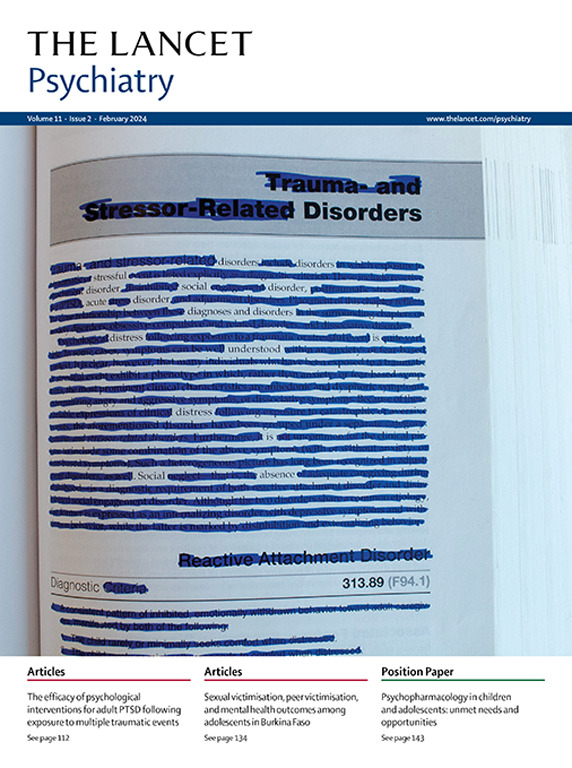Efficacy and safety of brexpiprazole in adolescents with schizophrenia: a multicountry, randomised, double-blind, placebo-controlled, phase 3 trial with an active reference
IF 30.8
1区 医学
Q1 PSYCHIATRY
引用次数: 0
Abstract
Background
New treatment options are needed for adolescent schizophrenia, partly due to an unfavourable risk–benefit profile of current options. This trial aimed to evaluate the short-term efficacy and safety of brexpiprazole in adolescents with schizophrenia.Methods
This multicountry, randomised, double-blind, parallel-arm, placebo-controlled, phase 3 trial with an active reference was done at 62 outpatient sites in ten countries. Eligible patients were aged 13–17 years with a primary DSM-5 diagnosis of schizophrenia and a Positive and Negative Syndrome Scale (PANSS) total score ≥80 at screening and baseline. Patients were randomly assigned (1:1:1) to oral brexpiprazole 2–4 mg/day, placebo, or aripiprazole 10–20 mg/day (active reference). Patients, investigators, and sponsor personnel were masked to treatment assignment. The primary efficacy endpoint was change from baseline to week 6 in PANSS total score (in randomly assigned patients who took at least one dose of study drug and had baseline and post-baseline PANSS evaluations). Safety was assessed in randomly assigned patients who took at least one dose of study drug. People with lived experience of schizophrenia were not involved in the research or writing process. The trial was registered with ClinicalTrials.gov, NCT03198078, and is complete.Findings
Between June 29, 2017, and Feb 23, 2023, 376 patients were screened, and 316 patients were randomly assigned to brexpiprazole (n=110), placebo (n=104), or aripiprazole (n=102). The mean age of patients was 15·3 years (SD 1·5). 166 (53%) of 316 patients were female and 150 (47%) were male. Of 316 patients, seven (2%) were American Indian or Alaskan Native, two (1%) were Asian, 21 (7%) were Black or African American, 204 (65%) were White, and 81 (26%) were other, as reported using US Census Bureau classifications. Mean doses of brexpiprazole and aripiprazole at last visit were 3·0 mg (SD 0·9) and 13·9 mg (4·7), respectively. Least squares mean change from baseline to week 6 in PANSS total score was –22·8 (SE 1·5) with brexpiprazole and –17·4 (1·6) with placebo (least squares mean difference –5·33 [95% CI –9·55 to –1·10]; p=0·014). The corresponding PANSS total score change at week 6 with aripiprazole was –24·0 (SE 1·6; least squares mean difference versus placebo –6·53 [95% CI –10·8 to –2·21]; pnominal=0·0032, not adjusted for multiple testing). Treatment-emergent adverse events were reported in 44 (40%) of 110 patients in the brexpiprazole group, 42 (40%) of 104 in the placebo group, and 53 (52%) of 102 in the aripiprazole group. The most common (incidence ≥5%) treatment-emergent adverse events were headache (n=7) and nausea (n=7) with brexpiprazole and somnolence (n=11), fatigue (n=8), and akathisia (n=7) with aripiprazole. Serious treatment-emergent adverse events were reported by one (1%) of 110 patients in the brexpiprazole group, three (3%) of 104 in the placebo group, and one (1%) of 102 in the aripiprazole group. No deaths were reported.Interpretation
In adolescents with schizophrenia, brexpiprazole 2–4 mg/day was associated with greater reduction in symptom severity than placebo over 6 weeks. The safety profile of brexpiprazole in adolescents was consistent with trials in adult patients. These results add to the body of evidence for brexpiprazole in adolescents with schizophrenia and might help to inform treatment selection in clinical practice.Funding
Otsuka Pharmaceutical Development & Commercialization and H Lundbeck.brexpiprazole治疗青少年精神分裂症的疗效和安全性:一项多国、随机、双盲、安慰剂对照的3期临床试验
背景:青少年精神分裂症需要新的治疗方案,部分原因是当前方案的风险-收益状况不佳。本试验旨在评估brexpiprazole治疗青少年精神分裂症的短期疗效和安全性。方法:这项多国、随机、双盲、平行对照、安慰剂对照的三期试验在10个国家的62个门诊点进行。符合条件的患者年龄为13-17岁,DSM-5诊断为精神分裂症,筛查和基线时阳性和阴性综合征量表(PANSS)总分≥80分。患者随机分配(1:1:1)口服布雷哌唑2-4 mg/天,安慰剂,或阿立哌唑10-20 mg/天(有效参比)。患者、研究者和赞助者被蒙面接受治疗分配。主要疗效终点是从基线到第6周PANSS总分的变化(随机分配的至少服用一剂研究药物并进行基线和基线后PANSS评估的患者)。安全性是在随机分配的患者中评估的,这些患者至少服用了一剂研究药物。有精神分裂症生活经历的人没有参与研究或写作过程。该试验已在ClinicalTrials.gov注册,编号NCT03198078,现已完成。在2017年6月29日至2023年2月23日期间,筛选了376名患者,其中316名患者随机分配到brexpiprazole (n=110), placebo (n=104)或aripiprazole (n=102)。患者平均年龄15.3岁(SD 1.5)。316例患者中女性166例(53%),男性150例(47%)。根据美国人口普查局的分类报告,在316例患者中,7例(2%)为美洲印第安人或阿拉斯加原住民,2例(1%)为亚洲人,21例(7%)为黑人或非裔美国人,204例(65%)为白人,81例(26%)为其他。末次访视brexpiprazole和aripiprazole的平均剂量分别为3.0 mg (SD = 0.9)和13.9 mg (SD = 4.7)。从基线到第6周,布雷克斯哌唑组PANSS总分的最小二乘平均变化为- 22.8 (SE为1.5),安慰剂组为- 17.4 (SE为1.6)(最小二乘平均差为- 5.33 [95% CI为- 9.55 ~ - 1.10];p = 0·014)。阿立哌唑治疗第6周相应的PANSS总分变化为-24·0 (SE 1·6;与安慰剂的最小二乘平均差- 6.53 [95% CI - 10.8至- 2.21];p标称值=0·0032,多次检测未调整)。brexpiprazole组110例患者中有44例(40%)出现治疗不良事件,安慰剂组104例中有42例(40%),阿立哌唑组102例中有53例(52%)出现治疗不良事件。最常见的治疗不良事件(发生率≥5%)是brexpiprazole组的头痛(n=7)和恶心(n=7), aripiprazole组的嗜睡(n=11)、疲劳(n=8)和静坐(n=7)。brexpiprazole组110例患者中有1例(1%)报告了严重的治疗不良事件,安慰剂组104例中有3例(3%),阿立哌唑组102例中有1例(1%)报告了严重的治疗不良事件。没有死亡报告。解释:在青少年精神分裂症患者中,6周内,布雷吡拉唑2-4 mg/天比安慰剂更能减轻症状严重程度。布雷吡拉唑在青少年中的安全性与成人患者的试验一致。这些结果增加了brexpiprazole治疗青少年精神分裂症的证据,并可能有助于临床实践中的治疗选择。fundingtsuka Pharmaceutical Development &;商业化和灵北。
本文章由计算机程序翻译,如有差异,请以英文原文为准。
求助全文
约1分钟内获得全文
求助全文
来源期刊

Lancet Psychiatry
PSYCHIATRY-
CiteScore
58.30
自引率
0.90%
发文量
0
期刊介绍:
The Lancet Psychiatry is a globally renowned and trusted resource for groundbreaking research in the field of psychiatry. We specialize in publishing original studies that contribute to transforming and shedding light on important aspects of psychiatric practice. Our comprehensive coverage extends to diverse topics including psychopharmacology, psychotherapy, and psychosocial approaches that address psychiatric disorders throughout the lifespan. We aim to channel innovative treatments and examine the biological research that forms the foundation of such advancements. Our journal also explores novel service delivery methods and promotes fresh perspectives on mental illness, emphasizing the significant contributions of social psychiatry.
 求助内容:
求助内容: 应助结果提醒方式:
应助结果提醒方式:


